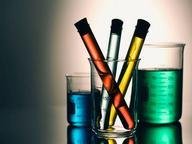Quiz Answer Key and Fun Facts
1. Let's start with a simple combustion: I take some methanol (CH3OH) and burn it with ample oxygen (O2) available. Apart from carbon dioxide (CO2), what other reaction product do I get? Give the formula, not the name!
2. Acids and bases can react quite violently with each other in a neutralization reaction. Let's take some sodium hydroxide (NaOH), dissolve it in water, and then add hydrochloric acid (HCl). After we evaporate the solvent, we are left with a crystalline substance. Please give its formula.
3. Often, mixing two different salts' solutions does not cause a reaction at all, but sometimes you almost instantly get a precipitate. When I mix a concentrated solution of sodium sulfate (Na2SO4) with one of calcium chloride (CaCl2), what is the resulting precipitate made of? Remember I am looking for the formula.
4. The next reaction I wish to present is a biochemical one - fermentation. Its input is glucose (C6H12O6) and its output consists of two substances. One is ethanol (C2H5OH), but what is the formula of the other product?
5. In organic chemistry, addition reactions combine two or more lighter molecules into one heavier one. Ethene (C2H4) thus reacts with elemental fluorine (F2) to form what compound? Give the simplest version of the formula (molecular formula).
6. You may remember this one from school because it is spectacular: Take a small sliver of an alkaline metal and drop it into water. Let's take potassium (K) for this question. The reaction will be violent and a gas will be produced in addition to various dissolved ions. What is the chemical formula of that gas?
7. If you want to have a good laugh, the next reaction might be for you. We'll carefully heat up some ammonium nitrate (NH4NO3) until it decomposes into two substances. One of them is water (H2O), but what is the formula of the other one? (Try eliminating as much water as you can from the original molecule and see what you have left over!)
8. No more dangerous substances now. Let's just take a bit of iron (Fe) and expose it to the elements for a few days. You will find a reddish substance flaking off, generated by the reaction of the iron with the oxygen in the atmosphere. But what is its formula? Be careful with the ratios!
(Chemistry experts: Ignore any possible hydration. I'm looking for the basic oxide.)
9. No good chemistry quiz could live without some sulfur for the proper olfactory component. We'll start by burning sulfur (S) or hydrogen sulfide (H2S) with an excess of oxygen (O2) in the presence of a catalyst to yield SO3, sulfur trioxide. Then we add some small amount of water to the result, giving us a strong acid. What is its formula?
10. Finally, I create a concentrated solution of silver nitrate (AgNO3). Then, I take a rod of pure copper (Cu) and just dip it into my solution for a while. Two things will happen: My previously clear solution turns blue and fine, usually black, crystals form on the copper. What is the formula for the material of which these crystals are made?
Source: Author
WesleyCrusher
This quiz was reviewed by FunTrivia editor
rossian before going online.
Any errors found in FunTrivia content are routinely corrected through our feedback system.
